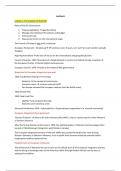Resume
Summary European Integration and Democracy Lecture Notes
- Cours
- Établissement
This guide travels through all the lecture material, week by week, in a clear and structured way. Allowing you to understand all the basic knowledge of the European Integration and Democracy Course from European Studies BA. For the exam, this is especially useful, due to the fact it is multiple...
[Montrer plus]



